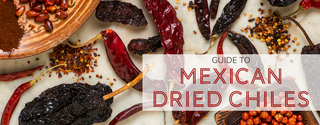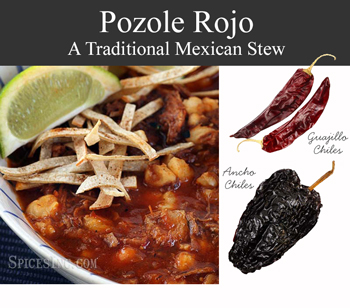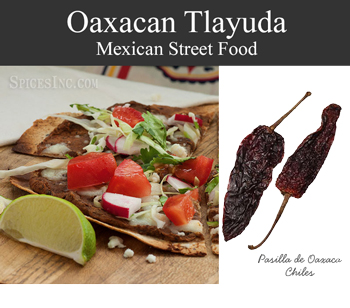Guide to Mexican Dried Chiles
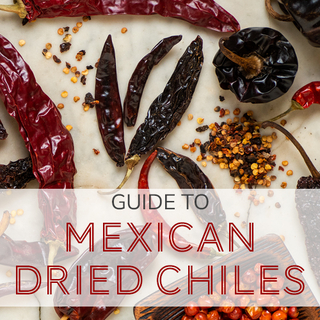
Mexico is famous for its richly flavored and spicy food and that is thanks in large part to the abundant use of chile peppers in their cuisine. We often think of the spicy tang of pickled jalapenos or the fresh crunch of a poblano when looking at Mexican chiles, and those are important, but dried chiles are the things that give Mexican food its depth and nuance as they bring their characteristic flavors to a wide array of dishes.
We’ve been learning about and sourcing chiles for more than a decade. Thanks to our work with suppliers, farmers, and academics, we’ve amassed an enormous amount of knowledge that we’re giving you here. We hope you find it helpful as you explore the world of Mexican dried chiles.
In this guide, you’ll find a comprehensive list of the most popular Mexican chile peppers available, complete with flavor profiles, heat ratings, ways to use them, and how to store them. We know the questions you need to answer, and they are all right here.
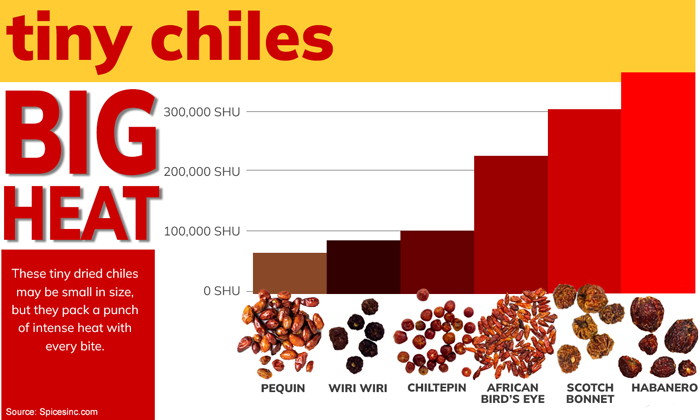
Guide to Mexican Dried Chiles
The dried chiles of Mexico come in an enormous array of shapes, sizes, flavors, and heat levels, so it’s important to make sure you know what you’re looking for when you prepare food. Chile peppers like the Guajillo can be mild and deliver a ripe fruit flavor that tastes like berries, while the Habanero has scorching heat and tastes of the tropics, with hints of papaya or mango.
The drying process often pulls out the nuanced flavors in a chile; you won’t get nuanced flavors of chocolate in a fresh poblano, but you will in one of its dried counterparts, the Mulato. Dried chiles are used in a wide variety of ways in Mexican cuisine; they’re often rehydrated and ground into a paste called sofrito that’s used as a cooking base, or in a thick, tomato-laced sauce called adobo. They can be used in combination with fresh chiles to create salsas with terrific complexity. Dried chiles are an integral part of dishes like mole poblano, considered to be Mexico’s national dish, and can be found in the classic Mexican and Tex-Mex foods familiar to American diners, like burritos or tacos, as well as in more traditional Mexican dishes that hold firm to Aztec roots, like tlacoyos or the tlayuda.
Table of Contents
What Are Mexican Dried Chiles?
How Do You Use Mexican Chiles?
How To Make Chile Powder From Dried Chiles
What Are Mexican Dried Chiles?
Mexican Dried Chiles are the chiles that can be found growing throughout Mexico, dried and prized for the flavors that concentrate in these chiles as the walls of the pepper dehydrate. Chile peppers have been cultivated in Mexico for thousands of years. The first wild chiles originated in the mountainous eastern half of Bolivia in approximately 7500 BC; by 6500 BC peppers had migrated north to Mexico and were fully domesticated by 4100 BC1.
Many commercial Mexican chiles available for export are grown on large corporate farms; the large number of chiles that are difficult to find outside of Mexico are often grown on small-holdings farms in rural areas. These farmers either lack the land or technical capability to increase their productivity beyond what they can sell at local farmers’ markets. Some chiles, like the poblano, can be found throughout all of Mexico; its name even translates as “villager”, and it was so named because it is so commonly available that it’s like everybody’s neighbor. But many chiles in Mexico are intensely region-specific, expressing the terroir of the area and defining the flavors of local cuisines. A variety of factors contribute to their difficulty to get outside of Mexico. There’s a limit to the productivity of small holdings farms, so some peppers are simply not grown in a large enough quantity to export. Some peppers may not travel well.
How Many Mexican Chiles Are There?
Mexico is home to 64 endemic varieties of chile2, though there are some sources that claim there can be as many as 150 different kinds of chiles that can be found growing in Mexico. We carry 19 Mexican dried chiles of the 64 available and are always looking to include others, if and when they become available.
 Names of Dried Mexican Chiles
Names of Dried Mexican Chiles
Many Mexican chiles have one name when they’re eaten fresh, and are given another name once they’re dried. We’ve found, through talking with our customers, that the names of the chiles can be a bit confusing. Mexican chiles are immensely popular and come in an enormous range of flavors and heat levels. Here’s a chart with a brief profile of each pepper, and what they’re called whether they are fresh or dried.
Aji Paprika chile – 120-140 SHU – A spicy ancestor of the Aji Paprika chile crossed the Atlantic with Christopher Columbus at the end of the 15th century. It retained its heat until the 1920s, when a Hungarian botanist grafted it onto a sweet pepper plant and created the mild chile we have today. The plant then came back to Mexico, where it is valued for its mild, earthy flavor and vibrant red color. It can be found growing all over Mexico. Name when fresh: Aji Paprika chile.
Ancho chiles – 1,000-1,500 SHU – Rich and plummy Ancho chiles are mild and easy to eat. This paddle-shaped chile—its name means “wide”—is found throughout Mexico and adds character and deep flavor to a huge variety of dishes. Name when fresh: Poblano peppers.
Cascabel chile – 1,000-2,500 SHU – The seeds in these chubby little chiles come loose as they dry and rattle around the inside of the pepper, hence the name, which means “jingle bell”. These peppers are nutty and warm with a mild heat and are grown mainly in the states of Guerrero and Jalisco. Name when fresh: Bola or bolita pepper.
Chiltepin chile – 50,000-100,000 SHU – This little juniper-sized berry packs a wallop, and has a pedigree. It’s a pint-sized furnace that can deliver heat that’s between 10 and 25 times hotter than a jalapeño pepper. It is also the pepper that shares the closest link to the very first chile pepper, which emerged in Bolivia 10,000 years ago. Traditionally grows in the Western side of the country, in the states of Sonora and Sinaloa, bordering the Gulf of California. Name when fresh: Chiltepin chile.
Chipotle Meco chile – 2,500-10,000 SHU – Chipotle Meco are the larger, smoky cousins of the Chipotle Morita. These peppers are smoked twice as long as a Morita and develop an intense smokiness, layered over the flavors of grass and berry that you’ll find in a ripe chipotle. It’s a favorite in the cuisine of Veracruz. Name when fresh: Jalapeño pepper.
Chipotle Morita chile – 2,500-10,000 SHU – The morita, or “little blackberry”, is a jalapeño pepper that has turned ripe and red on the vine and then smoked until it’s dry. The Aztecs realized this was an effective way to preserve peppers; the jalapeño has thick walls, so they are difficult to dry in the sun before they start to rot. Name when fresh: Jalapeño pepper.
Costeno Rojo chile – 5,000-15,000 SHU – The Costeno Rojo, or “coastal red”, chile pepper figures prominently in the kitchens of Oaxaca and Guerrero. This pepper is fruity and earthy, with a touch of bitterness. It’s a great substitute for a Chipotle. It can often be found in salsas. Name when fresh: Bandeno or casero pepper.
De Arbol chiles – 15,000-30,000 SHU – De Arbol chiles, or chile de árbol, are bursting with vibrant color and clean heat. This chile is found in Aguascalientes, Jalisco, Nayarit, and Zacatecas and is a favorite addition to salsas and marinades. These are the chiles that are often wound into decorative strands called ristras because they retain their intense color even after they are dried. Name when fresh: De Arbol chile or chile de arbol.
Guajillo chile – 5,000-8,000 SHU – Fruity and sweet, this mild-heat pepper is a Mexican favorite. This beautiful, russet-brown chile pepper has thin walls and a leathery appearance. It grows in abundance in Zacatecas but is immensely popular and can be found in most regions of Mexico. It goes beautifully in dry rubs and marinades. It is a member of the Mirasol family of chiles, which means it points toward the sky as it grows. Name when fresh: Guajillo chile or Mirasol pepper.
Habanero chile – 200,000-300,000 SHU – This little firebomb from the Yucatan is so much more than what meets the eye. They are approximately ¾ inch wide and perhaps 2 inches long, and they are packed with heat and flavor. Habaneros have a deliciously fruity aroma, like mango and apricot, and a rich flavor under the heat. The heat, however, is searing; it comes on quickly and likes to linger, so be ready when contending with habaneros. Name when fresh: Habanero chile.
Japones chiles – 15,000-30-000 SHU – Their name means “Japanese”, but this chile is all Mexican. Hailing from Jalisco and the Central Valley, the Japones chile has an uncomplicated flavor that opens it up for use in a variety of cuisines, though it became a favorite among various Asian cultures. It’s an easy substitute for de Arbol chiles, with which it is occasionally confused due to their similar appearances. Name when fresh: Japones chile.
Mulato chiles – 1,000-2,000 SHU – Smoky, chocolate-y, and resinous Mulato chiles deliver incredible depths of flavor and a family-friendly level of heat. They are native to Mexico’s Pueblo region but have been adopted into the cuisines of all the regions of Mexico, and are grown and sold all over the country. Name when fresh: Poblano pepper.
Organic Chipotle Morita chile – 5,000-10,000 SHU – Organic Chipotle Morita chiles deliver the bold flavor and smoky sweetness that has been a hallmark of this kind of chile pepper since Aztec cooks discovered the benefits of smoke drying. Today, Organic Chipotle Morita chiles are grown and processed in compliance with all standards of organic food production. Use this as you would any conventional Chipotle Morita. Name when fresh: Organic jalapeño pepper.
Organic Pasilla Negro chiles – 1,000-2,000 SHU – The Organic Pasilla Negro chile is rich and sweet, with a mild and approachable heat. It’s most famously used to make a rich mole sauce, but can be used in marinades, soups, or salsas. They are grown and processed in compliance with all standards of organic food production. Name when fresh: Organic chilaca chile.
Pasilla de Oaxaca chiles – 15,000-20,000 SHU – Pungent, smoky, and entirely distinctive Pasilla de Oaxaca, or Pasilla Mixe, is a culturally significant chile grown in the mountains of Oaxaca. They are allowed to ripen into redness and then dried in smoking huts, and the farmers who grow and process these peppers will not disclose their production secrets. Name when fresh: Chilaca chile.
Pasilla pepper – 1,000-1,500 SHU – This is part of the “holy trinity” of Mexican chiles that make up a mole; the other two chiles are the Ancho and the Guajillo. Pasilla Negro chiles taste woodsy and raisin-y—in fact, the name means “little raisin”—and are primarily grown in Aguascalientes, Jalisco, Guanajuato, and Zacatecas. Name when fresh: Chilaca chile.
Pequin chile – 30,000-60,000 SHU – Pequin chiles take their name from pequeño, the Spanish word for “small”, but their flavor is anything but. This spicy-hot little nugget tastes nutty and earthy and goes well with just about everything, from meats and cheeses to tomatoes and herbs. This is often confused with the Chiltepin because they are both small and powerful but the Pequin is more oval in shape while the Chiltepin is round. Originated in the state of Tabasco, and is still found growing wild all the way up to Texas. Name when fresh: Pequin chile.
Puya chile – 5,000-8,000 SHU – The name for this chile pepper translates as “goad”, like the steel prod suitable for poking. This pepper has a bit of a sting but underneath is fruity and rich, with flavors that are reminiscent of cherry and licorice. Grown in abundance in Zacatecas. They’re perfect for rehydrating for sauces and soups. Name when fresh: Puya chile.
Smoked Red Serrano chiles – 8,000-18,000 SHU – This medium-heat chile is mostly sold in the United States as a fresh green pepper; when it is smoked and dried, it loses its conventional grassiness for a berry-like flavor with notes of citrus. These peppers evolved in Puebla and Hidalgo, two mountainous areas that gave the pepper its name; serrano means “of the mountains”. It is now widely grown throughout Mexico, and is a favorite in salsa. Name when fresh: Serrano chile.
Are Mexican Chiles Hot?
There is an enormous range of heat levels available in the world of Mexican chiles. There are some Mexican chiles that are very hot, while many others fall on the milder side.
Mexican chiles are often bred to highlight their flavor rather than their heat, which is why so many chiles offer so much complexity and nuance. There are Mexican chiles that can please just about any palate, and while there is at least one exception to this, an easy way to judge the heat of a Mexican chile is by its size. The smaller they are, the hotter they tend to be.
The hottest Mexican chile pepper is the Habanero Chile; it is a heat grenade that packs up to 325,000 Scoville Heat Units (SHU) inside its tiny little body. For perspective, a Chipotle Morita—which is a dried jalapeño—measures at 10,000 SHU, so a Habanero is more than 30 times hotter than a Chipotle.
The mildest Mexican dried chile is the Ancho pepper. These family-friendly chiles measure between 1,000-1,500 family-friendly Scoville Heat Units. Ancho chiles are the workhorse of Mexican cuisine and can be found in just about every part of the country.
The “smaller is hotter” guideline for Mexican chiles does have its exceptions. One pepper that is notably small—only about 1.5 inches across—and decidedly not hot is the Cascabel. This pipsqueak of a chile clocks in at a very cozy 1,000-2,500 SHU. It demonstrates that there’s no direct shortcut to determining a Mexican chile pepper’s heat, and the best thing to do is get to know the chiles in question, or have a reliable source that you could refer to as needed.
Dark Vs Red Chile Color?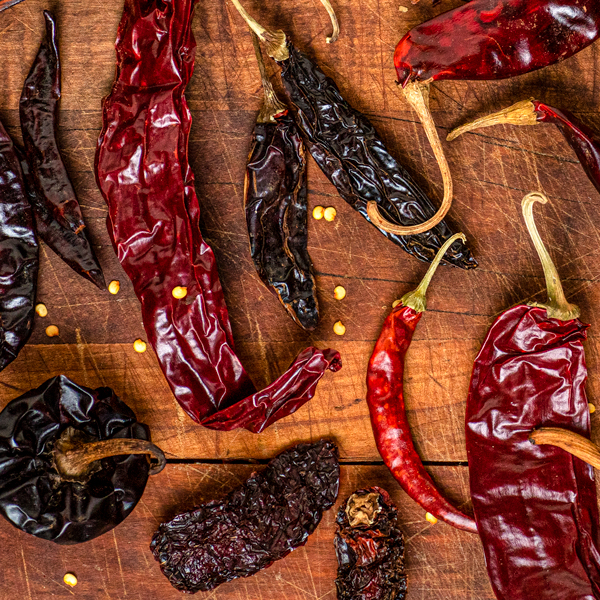
In basic terms, red Mexican chiles tend to be fruity, with heat levels that range from friendly and mild to scorchingly hot. Dark chiles have a more complex flavor, earthier and richer, and usually deliver mild-to-medium heat. This occasionally has to do with the way a chile is processed after it is picked, though in most cases the end color of a pepper has more to do with plant genetics than anything else.
Dark Chiles
Dark Mexican chiles look deep purple, brown, or almost black. They tend to have a relatively thick skin and are naturally sweet and may not be entirely mild, but are on the mild side. These are the chiles that deliver loads of deep, nuanced flavor to a dish. Most of these chiles obtain this color on their own, picked on the plant when they are have been allowed to mature, and then dried. The Mulato chile, a product of a poblano pepper, turns a deep mahogany at its final stage of ripeness. When it dries it turns nearly black. Its flavors concentrate into a welcoming, complex combination of deep raisin flavors, mixed with chocolate and licorice. Chipotle Morita turn dark purple, but part of the reason these chiles turn so dark is because they are smoke dried. But in keeping with the way dark chiles taste, the Chipotle chiles bring loads of flavor to the table, without an overabundance of heat.
Red Chiles
Red Mexican chiles fall somewhere on the red spectrum—they can be orangey, or red, or maroon, but they are clearly reddish. They tend to have thin skins and can be crumbled with relative ease. These chiles express flavors that are fairly straightforward—they taste like berries OR are vegetal, but not both. They also encompass a wide range of heat. Red chiles are often bred for their heat and have a clean burn that is more dominant than the flavors of the chile pepper. As a general rule of thumb, as red chiles get smaller, they get hotter. The Chiltepin chile is a tiny pepper that packs crazy-hot heat, though the hottest of the Mexican chiles is the Habanero, which is no bigger than the top of a thumb.
How Do You Use Mexican Chiles?
Mexican dried chiles are versatile ingredients that can be ground, flaked, or reconstituted and sliced, diced, or made into a paste that will bring savory, deep flavors and spicy heat to Mexican dishes.
Cut the chiles to remove the seeds and stems before processing, whether you’re making a powder or a reconstitution. Contrary to popular belief, you won’t be removing heat as much as you will any excess bitterness that can come from the dried seeds. Spread the chiles out and put them in a dry skillet over medium heat, and toast them until they’re fragrant. It should only take a minute or two. Alternatively, spread the chiles on a baking sheet and toast them in a 350°F oven, turning to prevent burning, until they are fragrant.
Once they’re toasted, you can put them in a spice grinder for flakes or powder. If you use a manual grinder, like a mortar and pestle or Mexican molcajete, it’s easier to monitor the size of the pepper as it breaks down, and you can readily stop at flakes. An electric grinder, like one used for coffee, will break the peppers down into powder very quickly.
To reconstitute, cover toasted peppers with hot water and let them sit for twenty minutes. Then drain the water and slice, dice, or mash in a mortar and pestle or food processor for a paste that will serve as a terrific flavor base in a wide range of dishes.
How To Make Chile Powder From Dried Chiles
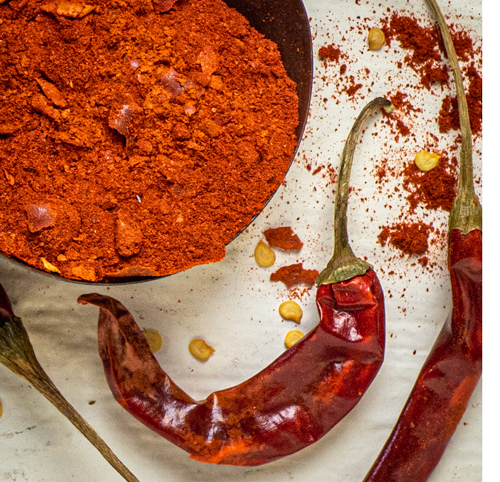 There are two simple ways to make chile powder from dried chiles; you can grind them straight out of the bag, or you can toast them before grinding them. The first way is incredibly quick and easy:
There are two simple ways to make chile powder from dried chiles; you can grind them straight out of the bag, or you can toast them before grinding them. The first way is incredibly quick and easy:
1. Take a barely damp cloth and wipe down your chiles to remove any sort of dust from the pepper.
2. Pull off the stem. Slit the chile open, and pull out the seeds, and any bit of pith that’s loose and easy to remove.
3. Tear the chiles into chunks and put them in a grinding device. You can use a coffee grinder that’s dedicated to spice grinding, or a manual grinder like a mortar and pestle. Grind the chiles to the desired size. They are ready to use!
The other way to make chile powder from dried chiles takes a few more steps, but these steps lead to more tasty results, since it brings the deeper flavors locked in the chile to the surface.
1. Take a barely damp cloth and wipe down your chiles to remove any sort of dust from the pepper.
2. Pull off the stem. Slit the chile open, and pull out the seeds, and any bit of pith that’s loose and easy to remove.
3. Put a skillet on the stove over medium to medium-high heat. When the skillet is hot, lay the chile peppers in the skillet. You can press them down with a spatula if they are wrinkled and don’t lie well on the flat cooking surface. Keep the chiles on the hot pan just until they turn fragrant; this should take anywhere from 30 seconds to 2 minutes, depending on the type of chile you are toasting. They may puff up during this process, but that’s fine. Remove them from heat before they start to burn and set them to the side. Continue this until your desired amount of chiles are toasted.
4. Let the chiles sit on the counter until they are cool enough to handle. Then tear them into chunks and put them in a grinding device. You can use a coffee grinder that’s dedicated to spice grinding, or a manual grinder like a mortar and pestle. Grind the chiles to the desired size. They are ready to use!
How Long Do Dried Peppers Last?
Dried peppers can have a shelf life of 2-3 years if they are properly stored and protected. It’s generally suggested that whole chile peppers can retain their vigor for up to two years, but there’s no set “use-by” date on a bag of dried chiles. The secret is in the storage.
Chile peppers need to be protected from air, light, heat, and moisture. Air can help extract volatile oils and any remaining pliancy out of a chile and age it prematurely, turning it brittle. Light can heat up the storage container; exposure to light will leach the color and flavor out of the pepper. Keeping a pepper in a warm environment, like somewhere near your stove, can cause the pepper to start to sweat since it’s not entirely bone-dry in its packaging. This introduces moisture into the storage, which is a death knell for dried peppers. Moisture can usher in the creation of mold, which can often mean that you need to discard the entire package of peppers, not just the one on which you see mold.
If you keep chile peppers in a sealed container in your pantry, away from potential contaminants and other factors that negatively impact shelf life, you should be able to store chiles successfully for 2, or even 3, years. There are sources that claim chile peppers can be stored for up to 5 years, but that’s pushing your luck and would require incredibly fastidious attention to storage. In all likelihood, this lengthy amount of storage is not practical to plan for.
You should always take the time to check your chiles for vibrancy before cooking with them. Remove them from the package and feel them to see if whether they are still pliant and have retained their proper color, or look pale, dry, and crumbly. Look for mold. Crush a little bit in between your fingers and smell them. If they are brittle or ashy, have mold, or have no aroma, they are no longer good to use. Discard those peppers and get new ones.
Finally, you can store dried chile peppers in the freezer, but when they’re stored in that manner they are only good for about a year. Taking chiles in and out of a freezer makes them susceptible to the infiltration of moisture, and leaving them in there makes them susceptible to freezer burn. Wrap chiles that you plan to store in a freezer individually so you can easily take what you need for the recipe you’re preparing, and leave the rest in there until you’re ready to cook again.
Learning to work with Mexican dried chiles opens a wealth of flavor right in your kitchen. Whether you’re looking for chiles that have rich flavors and mild heat or clean flavors and high heat, the chiles of Mexico have what you’re looking for. With patience and attention to the types of peppers in front of you, you’ll be an expert in no time.
References
1. Burton, T. (2014, January 6). Chiles, one of Mexico's heritage crops: Geo-Mexico, the geography of Mexico. Geo-Mexico. Retrieved June 1, 2022.
2. Más de México Editorial Staff. (2019, November 6). Estos son los 64 tipos de chiles que crecen en México (infográfico). Más de México. Retrieved June 1, 2022.

